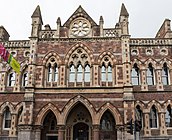File:Cutleaf false oxtongue - Unknown - 19 1927 2 19.jpg

原始文件 (1,722 × 2,480像素,文件大小:2.28 MB,MIME类型:image/jpeg)
摘要
| Cutleaf false oxtongue
( |
||||||||||||||||||||||||
|---|---|---|---|---|---|---|---|---|---|---|---|---|---|---|---|---|---|---|---|---|---|---|---|---|
| 艺术家 |
Unknown Indian artist |
|||||||||||||||||||||||
| 标题 |
Cutleaf false oxtongue |
|||||||||||||||||||||||
| 描述 |
Oils from this plant have been shown to kill juvenile mosquitos. This painting is part of local amateur botanist Richard Cresswell’s (1815-1882) collection. It is one of 86 Indian paintings (mostly botanical) and dates to the early 1800s. Many of the plants depicted in this collection were known for their use in Ayurvedic medicine. One of the world’s oldest medicinal systems, it has been practised in India for 3,000 years. Between the late 18th and mid-19th centuries, the British East India Company extended its control over much of the Indian subcontinent. Keen to exploit and export valuable natural commodities, the Company set out to record the flora and fauna of India. It commissioned Indian artists to create detailed illustrations but officials rarely recorded their names. British scientists supervised the work and paper from England, made by companies such as Whatman, was imported for use. The East India Company relied on Indian practitioners to help treat its officials as often the diseases they contracted had not been encountered before and western medicine proved ineffective. It also saw opportunity to export the plants used in medicine, and for food, dyes and timber, for huge profit exploiting India’s traditional knowledge systems and natural resources. Responding to British patronage, Indian artists developed a new style of painting, mixing Indian and European traditions. This has come to be known as the ‘Company School’ art and these paintings belong to that broad tradition. It was common for officials (who were not employed as medics or botanists) to build their own personal collections of paintings. The flora and fauna depicted was sometimes from their own gardens and menageries. We cannot be sure how Richard Cresswell came by this collection of Company School works. It is plausible they came to him via his wife’s family. Frances Creighton (1821-1904) was born in Bengal where her father, Robert (1797-1827), was a judge. Research suggests that his father was Henry Creighton (1764-1807). Charles Grant, a senior Company official, appointed Henry manager of an indigo factory at Guamalati. He is best known for his research and paintings on the ruins at Gaur. It is possible Henry commissioned the botanical drawings and they were passed down through the family. However, research has not yet uncovered any evidence for this connection. 17 of the 86 works have attributions on the reverse. These three artists, Sheikh Zain al-din, Ram Das and Bhawani Das, are known to have worked for Lady Mary Impey, wife of Sir Elijah Impey the Chief Justice of the Supreme Court of Calcutta. There is also evidence that they worked for Anna Maria Jones, the wife Sir William Jones, after the Impeys returned to Britain. |
|||||||||||||||||||||||
| 日期 |
1933年 date QS:P571,+1933-00-00T00:00:00Z/9 |
|||||||||||||||||||||||
| 尺寸 | 555 x 390mm | |||||||||||||||||||||||
| 藏于 |
institution QS:P195,Q7373646 |
|||||||||||||||||||||||
| 现存地点 |
Fine Art |
|||||||||||||||||||||||
| 登录号 | ||||||||||||||||||||||||
| 创作地点 | Calcutta | |||||||||||||||||||||||
| 荣誉行 | Royal Albert Memorial Museum & Art Gallery | |||||||||||||||||||||||
| 题记 |
HERB. MUS. EXON CRESSWELL COLLECTION 19/1927 Blumea Laciniata DC No 26 |
|||||||||||||||||||||||
| 来源/摄影师 | Royal Albert Memorial Museum & Art Gallery | |||||||||||||||||||||||
| 授权 (二次使用本文件) |
|
|||||||||||||||||||||||
许可协议
| 本作品采用知识共享CC0 1.0 通用公有领域贡献许可协议授权。 | |
| 采用本宣告发表本作品的人,已在法律允许的范围内,通过在全世界放弃其对本作品拥有的著作权法规定的所有权利(包括所有相关权利),将本作品贡献至公有领域。您可以复制、修改、传播和表演本作品,将其用于商业目的,无需要求授权。
http://creativecommons.org/publicdomain/zero/1.0/deed.enCC0Creative Commons Zero, Public Domain Dedicationfalsefalse |
说明
受版权保护,并由版权所有者释出于公有领域 简体中文(已转写)
摄影器材 简体中文(已转写)
佳能 EOS 5D Mark II 中文(已转写)
文件历史
点击某个日期/时间查看对应时刻的文件。
| 日期/时间 | 缩略图 | 大小 | 用户 | 备注 | |
|---|---|---|---|---|---|
| 当前 | 2024年5月23日 (四) 14:53 |  | 1,722 × 2,480(2.28 MB) | NowMesPetits | pattypan 22.03 |
文件用途
以下页面使用本文件:
全域文件用途
以下其他wiki使用此文件:
- www.wikidata.org上的用途
元数据
此文件中包含有扩展的信息。这些信息可能是由数码相机或扫描仪在创建或数字化过程中所添加。
如果此文件的源文件已经被修改,一些信息在修改后的文件中将不能完全反映出来。
| 图像标题 |
|
|---|---|
| 相机制造商 | Canon |
| 相机型号 | Canon EOS 5D Mark II |
| 著作权持有人 |
|
| 曝光时间 | 1/60秒(0.016666666666667) |
| 光圈值 | f/14 |
| 感光度(ISO) | 50 |
| 数据生成日期时间 | 2016年1月26日 (二) 12:38 |
| 镜头焦距 | 90毫米 |
| 来源 | Royal Albert Memorial Museum & Art Gallery |
| 使用条款 |
|
| 宽度 | 3,337 px |
| 高度 | 4,806 px |
| 每色彩组分位数 |
|
| 压缩方案 | 未压缩 |
| 像素构成 | RGB |
| 方向 | 正常 |
| 色彩组分数 | 3 |
| 水平分辨率 | 300 dpi |
| 垂直分辨率 | 300 dpi |
| 数据排布 | 大块格式 |
| 使用软件 | Adobe Photoshop Elements 11.0 Windows |
| 文件修改日期时间 | 2023年12月22日 (五) 15:47 |
| 曝光程序 | 手动 |
| Exif版本 | 2.2 |
| 数字化日期时间 | 2016年1月26日 (二) 12:38 |
| APEX快门速度 | 6 |
| APEX光圈 | 7.625 |
| APEX曝光补偿 | 0 |
| 拍摄对象距离 | 0米 |
| 测光模式 | 多区 |
| 闪光灯 | 闪光灯未点亮、闪光灯强制关闭 |
| 色彩空间 | 未标定 |
| 焦平面分辨率单位 | 英寸 |
| 文件来源 | 数码相机 |
| 场景类型 | 直接拍摄的图像 |
| 曝光模式 | 手动曝光 |
| 白平衡 | 手动白平衡 |
| 相机序列号 | 1931201551 |
| 使用的镜头 | TS-E90mm f/2.8 |
| 元数据最后修改日期 | 2024年4月18日 (四) 11:50 |
| 原始文件唯一ID | xmp.did:38FFADCAE6E1E5118401D36C3776AD98 |
| 著作权状况 | 著作权状况未设置 |
| IIM版本 | 4 |


